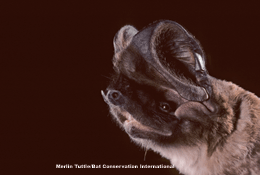Animal Fact Sheet: Greater Mastiff Bat |
Identifying Features The greater mastiff bat (Eumops perotis) is the largest bat in the United States. They can be easily identified by their very large ears which extend out over its nose. It has short brown to gray-brown fur on its back and paler fur on its underside. Their wings are long and narrow.
|
 |
Migration/Hibernation These bats do not migrate or hibernate. They remain active year-round. |
Habitat Ideal habitat for this bat must have large open area with roost sites having vertical faces. They will roost in small colonies in rock fissures in high cliff faces. Because of their large size, they need at least 20 feet of vertical drop from their roosts to gain enough speed for flight. If they end up on the ground, they have to climb up a vertical surface in order to gain enough height to launch into flight. |
Range These bats are found from central California into most of Arizona and some areas of Texas and New Mexico and into Mexico. The southern portion of their range extends to Argentina. |
Wild Status Currently these bats are considered a species of least concern and have federal special status. Bat Conservation International however does consider this bat to be Threatened and Endangered due to no longer being found in many of its previously occupied areas. |
Diet They are insectivorous, and although moths are probably their food of choice, any night-flying insect is game. |
Predators Typical bat predators include birds of prey such as hawks, falcons and owls. |
Reproduction Mating occurs in the spring. Usually one, but on occasion two pups are born sometime between May and September. |
Life Span It is estimated that their life span is 10-15 years in the wild. |
Size Its wingspan is 20-23 in (50-58cm) and it weighs about 2.0-2.5 oz (56-70 g).. |
Extra Fun-facts
|